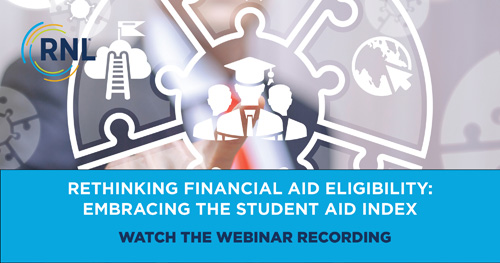enrollment
The Student Aid Index: Shifting Our Thinking on Financial Aid Eligibility
This blog was co-authored with Derek Flynn and Adam Connolly
We have had many disruptors in higher education over the last several years, and this year, we have a new one that will have a major impact on financial aid awarding: the Student Aid Index.

The Student Aid Index (SAI) is one of three parts of the Appropriations Act of 2021: FAFSA simplification, the SAI, and changes to the Pell Grant calculation. These changes should make the financial aid process better for students and families. They hopefully will make them better for financial aid professionals. But the change is daunting for those of us working in enrollment and financial aid. Our colleagues have expressed worries about this since the announcement, and as the change approaches, we are hearing a lot of anxiety from colleges and universities about the transition to SAI. In fact, at a recent webinar on the SAI transition that we held, two-thirds of our attendees felt unprepared or unsure about their preparation for the SAI transition.
Here’s the thing to remember: we have handled disruptors before very well. The change to prior-prior year caused much concern nearly a decade ago, yet we successfully handled that transition. The pandemic brought on a need for test-optional consideration for campuses that would have not otherwise considered it an option. We were able to handle that, too. But how do we handle this transition, which is admittedly the biggest change we have seen to awarding in our 30+ year careers?
Use FAFSA simplification to drive FAFSA participation
FAFSA completion is critical. It’s not only essential to make college affordable and accessible to students and families—it’s also a predictor of enrollment. In recent years, especially after the pandemic, FAFSA filing rates have been eroding, which has also led to a decline in Pell-eligible students.
FAFSA simplification is a way to address that decline. For starters, it reduces the number of questions from 108 to 33 (although, as with many aspects of this shift, that may change by the time everything is final). Students and families will certainly be happy to have one-third of the questions to answer in applying for financial aid. We are also already seeing some rebound of FAFSA completion, with August 2023 completions up by 4% compared to one year ago.
The point is that the FAFSA should be easier for families to complete, making them more likely to complete it. Make sure you emphasize that with your incoming students.
SAI is the new EFC
Expected Family Contribution was established as a measurement of wealth among filers. That will now give way to the SAI. The SAI is also a measurement of wealth in its own way, but it is an actual index, not a dollar amount. This flow illustrates the shift from EFC to SAI.

SAI requires some rethinking of need. The index can go down to -1,500 for the most needy students. However, the lowest it can go for the calculation of need is zero. There are some similarities in the current needs analysis formula, but the SAI will also be used to calculate eligibility for institutional dollars. That’s your money. When you think about how you build your aid strategy, if you have financial groupings or other mechanisms or guardrails for allocating your institutional resources, the SAI will now be that guardrail for doing so.
Pell Grant eligibility and SAI
Pell Grants are another significant change. Students can now preview their Pell eligibility using AGI and household size. Minimum and maximum Pell Grants will be based on this Pell calculation, but Pell Grant awards in the middle ranges will be slightly different. That eligibility will be determined by subtracting the SAI from the maximum Pell Grant.
This last point is one of the more challenging things to wrap one’s head around: SAI will be used to calculate financial aid, but Pell Grants will not be tied to SAI. This is a big change. We no longer have Pell Grants tied directly to an EFC. SAI will certainly be an indicator of the probability of Pell Grants—a lower SAI has a higher likelihood of Pell. However, there will be some negative SAI students who do not get a full Pell Grant and a small percentage of high SAI students who may receive a Pell Grant.
Use the NASFA tool and take action to be ready for the SAI transition
We encourage our campus partners to run your data through the NAFSAA Student Aid Index Modeling Tool. It’s a fantastic resource. It’s also not a light lift—leave yourself some time to spend with it to get the data you need into the tool, as well as time to digest the monster file it produces. But what it will help you understand is, based on the data you provide:
- How many students who are currently getting Pell will still get Pell?
- How many students who are getting Pell won’t get Pell?
- How many students getting Pell will have a change in Pell?
Keep exploring strategies for the SAI transition
This is a lot to process. I encourage you to watch the entire webinar we presented, where we dive into more detailed examples of how to handle the SAI transition. We are also here to help. RNL works with 250 institutions each year on financial aid awarding, and we have been helping our campus partners navigate these changes. We would be happy to share our insights with you—reach out for a complimentary consultation and we will schedule a time to talk.
Talk with our enrollment experts
Let’s talk about how you can find the optimal strategies for digital marketing, inquiry management, financial aid awarding, optimizing yield, and other key actions.
